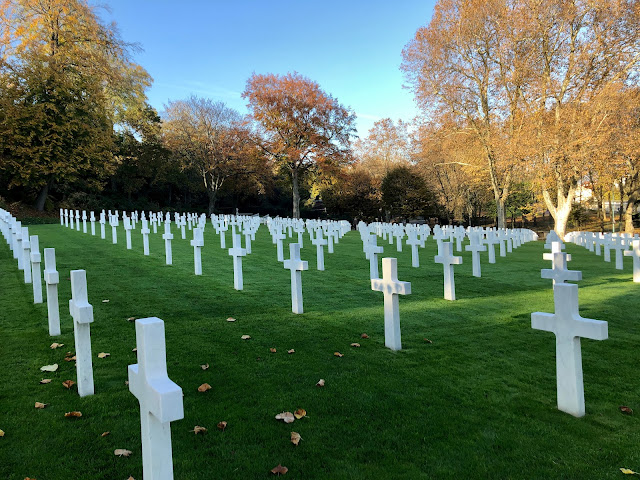We went to the Arc de Triomphe this morning, and watched as the ceremony unfolded, with military parading up the Champs-Élysée in wave after wave, on horseback, motorcycles, cars, and tanks. One of the tanks carried the flag draped coffin of the last surviving member of the Companion of the Order of Liberation, an honor awarded to French WWII heroes, who died on October 12. President Macron made remarks, with a big Jumbotron just to the side of the Arc de Triomphe, broadcasting just feet from where he was actually standing. US Vice President Kamala Harris was there and scores of dignitaries.
We took the metro from the Arc de Triomphe to Suresnes American Cemetery, on Mont Valérian. Mont Valérian is 161m at it’s peak and was the site of religious pilgrimages for several centuries, overlooking the city of Paris. A military fortress was built there in the mid 1800’s, to protect the capital. From 1941 to 1944, more than 1000 hostages, Jews, communists, and resistance fighters were executed during the German occupation. In 1960, General de Gaulle, inaugurated the Memorial to Combatant France on Mont Valérian. Suresnes American Cemetery was designed in 1922, on the edge of Mont Valérian, and contains the remains of 1541 Americans who died in WWI plus 24 unknown dead of WWII.
Just after lunch, at the entrance to Mont Valérian, the military entourage carrying the coffin of the last surviving member of the Companion of the Order of Liberation, came down the street on top of a French tank, for burial at Mont Valérian. We walked through Suresnes American Cemetery and memorial chapel. It was humbling to think about the 116,516 Americans that lost their lives in WWI. It was more humbling to think about the 1,927,000 French soldiers that died in WWI, of the French population of 39,000,000 at the time. WWI left many French villages, drained of their active male population. When traveling in France, we make an effort to stop at WWI memorials in villages, and it is obvious why many of those villages were much larger in the early 1900’s than they are today. Their loss of lives was never recovered.














